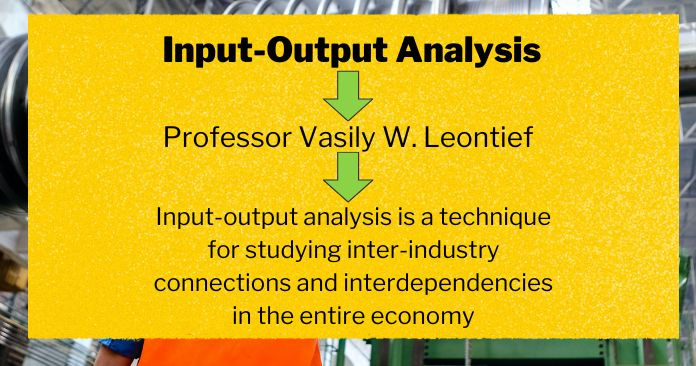Professor Vasily W. Leontief pioneered input-output analysis technology in 1951. An input is a product or product of an entrepreneur or manufacturer that is the result of a productive effort. An output is something that an entrepreneur creates and sells, and that is acquired with the goal of employing it in an enterprise. As a result, the company’s input is its cost, and its output is its profit.
Input – expenditure of the firm
Output – income of the firm

In a brief, input-output analysis is a technique for studying inter-industry connections and interdependencies in the entire economy, where one industry’s input equals another industry’s output. Production is the most important aspect of economic activity.
Intermediate goods, often known as inputs, are products that are produced by one industry but are used as an investment in the creation of another.
In this way, it’s a cyclical process that many industries go through on a regular basis. In a perfect equilibrium input-output analysis, the monetary value of an economy’s total output should be equal to the financial worth of all the inputs and outputs taken into account.
Main Features of the Input-output Analysis
The main features of the input-output analysis are
- The analysis is applicable to an equilibrium economy and an economy with partial equilibrium.
- This technology’s main purpose is to study and consider the product’s technical concerns, as it has nothing to do with demand analysis.
- This analysis is based on empirical study.
- There are two parts to input-output analysis. The first step is to create an input-output table, and the second step is to apply the input-output model in a systematic way.
Assumptions of the Input-output Analysis
- The economy is in perfect equilibrium
- The whole economy can be divided into two sectors. The inter-industry sector and the final demand sector. Each section can be subdivided further.
- Each industry produces only one product, and no two products are produced together.
- A company’s total production is used as input by another company or the final demand section.
- Production is followed according to the law of constant returns to scale.
- In the economic area, the level of technological progress remains constant, so the input coefficients remain constant.
- There are no external economies or production diseconomies.
Types of Impacts in I-O Analysis
Three types of impact are estimated using input-output analysis.
- Direct impact
- Indirect (secondary) impact
- Induced (tertiary) impact
Direct impact: The impact of a change in final demand on the consumption of inputs that are directly related.
Indirect (secondary) impact: This would result from input providers hiring people to meet demand.
Induced (tertiary) impact: Describes the rise in personal consumption of products and services as a result of suppliers’ employees.
What is input-output analysis in Matrix?
An input-output model represents national or regional economic accounting, which records how industries trade with each other as well as how they produce for consumption and investment.
Limitations of the Input-output Analysis
- The assumption of constant co-efficiency of the product does not take into account the ability to substitute factors. Although short-lived there is always some replacement potential and in the long run, the replacement potential may be relatively high.
- The assumption of linear equations relating to one industry’s output and its applicability in other industries does not seem to be realistic. Since the factors are largely indivisible, it is not always necessary to increase the inputs proportionally to increase the output.
- The input-output model is oversimplified and limited, with a particular emphasis on the product side of the economy. It doesn’t explain why its inputs and outputs follow a specific economic pattern.
- The input-output model relies on complicated equations. The initial step is to determine the pattern of equations, followed by locating the required huge amounts of data. Equations need a good understanding of higher mathematics, and accurate data is difficult to come by. As a result, the input-output model becomes complex and difficult to understand.


